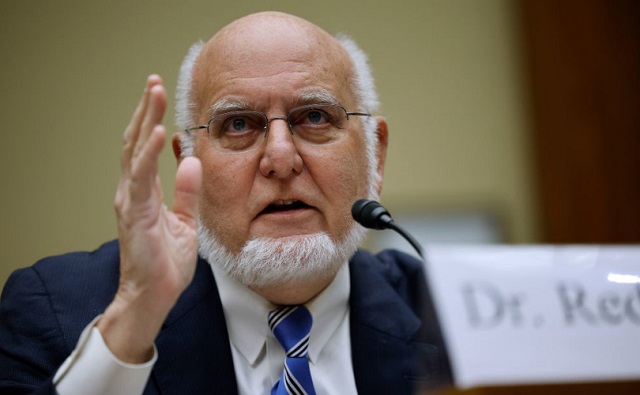Great Reset
Actress posing as gender-confused girl prescribed testosterone within minutes at Quebec clinic

From LifeSiteNews
The video, released by Radio-Canada, features an actress posing as a 14-year-old patient at a Quebec clinic being prescribed testosterone and consulted about surgeries after merely 9 minutes.
The French language arm of the Canada’s state broadcaster has published an investigative report on the gender “transitioning” children, revealing that an actress posing as a 14-year-old patient was prescribed testosterone after just nine minutes of consultation.
On February 29, Radio-Canada, the French arm of the state-funded Canadian Broadcasting Corporation (CBC), released a documentary showing an actress posing as a 14-year-old patient at a private “gender clinic” in Quebec being prescribed testosterone and advised on life-altering mutilating surgeries during a consultation that lasted a meagre nine minutes.
“You can tell me, a little deep down, since when did you know you were not in the right body?” the unnamed female doctor asked the actress posing as 14-year-old gender-distressed patient “Sacha,” who was attending her first “gender” consultation appointment, without parental involvement.
The actress, posing as Sasha, told the doctor that she vomited at age 12, after which her mother took her to see a psychologist who said she had an eating disorder.
“I told myself that it couldn’t be eating disorders. It didn’t make sense in my head,” Sacha told the doctor. “But at 13, I came across a video of a trans person [sic] who talked about having eating disorders, but in fact it was because she was in the wrong body.
“At that moment, I really recognized myself in that person,” she relayed.
After only five minutes, the doctor asked the young girl if she was considering surgeries, mentioning specifically mastectomies, the permanent removal of the girl’s breasts. The actress replied saying “yeah.”
“There are other surgeries that exist,” the doctor mentioned. “We have a uterus at the bottom, with ovaries. So basically, it’s possible to remove. It’s something that can cause dysphoria.”
The doctor proceeded to ask the 14-year-old Sacha if she was interested in preserving her fertility before going on to prescribe testosterone, which can cause infertility.
“Is fertility, I understand that it is perhaps far away for you at 14, but is fertility something you want to maintain before you start?” the doctor asked.
“No, I always knew I don’t want children,” Sacha responded.
Finally, after less than nine minutes, the doctor told Sacha that she would prescribe her testosterone, despite the permanent impact it can have on fertility and the host of other health issues it can cause.
“Basically, the logic right now, I will prescribe hormones today, because the logic is that, basically there is nothing in your profile that would stop me from giving you hormones,” the doctor explained.
“I’ll start at one dose. It’s not a mini-dose. It’s like an intermediate dose between adults and non-binary, let’s say,” the doctor added.
“Okay,” the young girl responded.
“No problem. The best is yet to come,” the doctor promised.
When Radio-Canada confronted the doctor after the appointment, questioning how such drastic action can be taken with such a short period of consultation, the doctor said, “A medical consultation cannot be evaluated in terms of duration, but rather in terms of quality of the exchange of information.”
According to Radio-Canada, wait times to get into gender “transitioning” clinics are increasing. As a result, some are going to private clinics who can give letters of recommendation for hormone therapy after one or two sessions. The sessions cost between $115 and $120.
A 14-year-old girl walked into a private clinic in Quebec, said she was trans, and was given a testosterone prescription in less than 9 minutes!
The doctor also started asking her about surgeries, and if she wanted to preserve her fertility after only 5 minutes!
Yes, this was… pic.twitter.com/MtreLWgJ65
— Billboard Chris 🇨🇦🇺🇸 (@BillboardChris) March 7, 2024
Chris Elston, a prominent Canadian parental rights advocate known as “Billboard Chris,” responded to the documentary on X, telling Radio-Canada, “this doctor needs to be investigated by the College des Medicine du Québec. How can I find out her name?”
“Unreal,” tech mogul and free speech advocate Elon Musk said in response to Elston’s post.
The documentary is going viral online the same week leaked internal communications show doctors who offer so-called “gender-affirming care” know that transgender hormones cause serious diseases, including cancer.
On Monday, journalist Michael Shellenberger released the internal documents from the World Professional Association for Transgender Health (WAPTH), which “is considered the leading global authority” on so-called “gender medicine,” despite being an LGBT activist group.
The “WPATH FILES” include emails and messages from an internal discussion forum by doctors, as well as statements from a video call of WPATH members. The files reveal that the doctors working for WPATH know that so-called “gender-affirming care” can cause severe mental and physical disease and that it is impossible for minors to give “informed consent” to it.
As LifeSiteNews has previously noted, research does not support the assertions from transgender activists that surgical or pharmaceutical intervention to “affirm” confusion is “necessary medical care” or that it is helpful in preventing the suicides of gender-confused individuals.
In fact, in addition to asserting a false reality that one’s sex can be changed, transgender surgeries and drugs have been linked to permanent physical and psychological damage, including cardiovascular diseases, loss of bone density, cancer, strokes and blood clots, infertility, and suicidality.
There is also overwhelming evidence that those who undergo “gender transitioning” are more likely to commit suicide than those who are not given irreversible surgery. A Swedish study found that those who underwent “gender reassignment” surgery ended up with a 19.2 times greater risk of suicide.
Indeed, there is proof that the most loving and helpful approach to people who think they are a different sex is not to validate them in their confusion but to show them the truth.
A new study on the side effects of transgender “sex change” surgeries discovered that 81 percent of those who had undergone “sex change” surgeries in the past five years reported experiencing pain simply from normal movement in the weeks and months that followed — and that many other side effects manifest as well.
Additionally, LifeSiteNews compiled a list of medical professions and experts who warn against transgender surgeries, warning of irreversible changes and lifelong side effects.
International
Switzerland’s new portable suicide ‘pod’ set to claim its first life ‘soon’

From LifeSiteNews
In what feels like a dystopian movie, Switzerland’s new portable death “pod” to allow people to kill themselves is on track to claim its first victim this year.
In a July 16 press conference, Florian Willet, chief executive of pro-euthanasia organization The Last Resort, announced that Switzerland will “soon” use its portable suicide pod to end a life for the first time.
“Since we have people indeed queueing up, asking to use the Sarco, it’s very likely that it will take place pretty soon,” Willet said, eerily describing it as a “beautiful way” to die.
The pod is called Sarco, short for sarcophagus, the name of the coffins in which ancient Egyptian pharaohs were buried. The futuristic-looking 3D-printed capsule was first unveiled in 2019 for assisted suicide in Switzerland but was met with controversy.
It’s founder, Philip Nitschke, who has been nicknamed “Dr. Death” for his attempt to “glamorize” suicides, explained how the pod works in a recent interview with the South China Morning Post.
Once a person is inside the pod, they are asked who they are, where they are and if they know what happens when they press the button.
The death in the pod can also be activated by a button, gesture, voice control, or blink of the eye for those who cannot vocally or physically communicate due to severe illness or mobility issues.
After they answer, a voice says, “If you want to die press this button.” Once the button is pressed, the pod is flooded with nitrogen causing the oxygen to plummet from 21 per cent to 0.05 per cent in the air in less than 30 seconds.
“They will then stay in that state of unconsciousness for … around about five minutes before death will take place,” Nitschke explained.
However, he warned that, “Once you press that button, there’s no way of going back.”
The death inside the pod is filmed, and the footage is handed to a coroner.
The push to debut the pod this year comes after the pod was banned earlier this month after prosecutors questioned the legality and ethics of the pod, pointing out that it is unclear who is responsible for the death and who operates the pod.
Switzerland has allowed assisted suicide since 1942, with its only requirements being that the person freely chooses death, is of sound mind, and that their decision is not motivated by selfish reasons.
The county’s broad euthanasia policy has made it a tourist attraction from those around the world who wish to end their lives.
In addition to the legal question of who is responsible for the death, pro-life organizations have condemned the pods for trivializing death and undermining the dignity of life.
“Philip Nitschke’s device has been condemned by a broad range of commentators,” James Mildred, director of engagement for pro-life organization Christian Action Research and Education (CARE), said.
“Many people feel that it trivialises, and even glamourises, suicide,” he explained.
“We believe that suicide is a tragedy that good societies seek to prevent in every circumstance,” Mildred continued. “There are ethical ways to help human beings that don’t involve the destruction of life.”
Censorship Industrial Complex
New federal legislation should remind Canadians of Orwell’s 1984

From the Fraser Institute
By Jake Fuss and Alex Whalen
The legislation seeks to punish citizens not just for what the governments deems as “hate speech” but also grants the state power to bring Canadians before tribunals on suspicion that they might say something hateful in the future.
This year marks the 75th anniversary of George Orwell’s classic novel 1984 (and it’s been 40 years since the actual year 1984). In the novel, Orwell explains the dangers of totalitarianism by exploring what happens when government exercises extreme levels of control over citizens including censoring and controlling language. While Canada is a relatively free country in 2024, there are aspects of Orwell’s world reflected in government policy today.
The Human Freedom Index, published annually by the Fraser Institute and Cato Institute, defines freedom as a social concept that recognizes the dignity of individuals by the absence of coercive constraint. In a free society, citizens are free to do, say or think almost anything they want, provided it does not infringe on the right of others to do the same.
Canada currently fares relatively well compared to other countries on the Human Freedom Index, placing 13th out of 165 countries. However, our score has dropped six spots on the index since 2008 when Canada recorded its highest ever rank.
This is not surprising given the Trudeau government’s recent efforts to control and manage the free exchange of ideas. The recent Online Streaming Act imposes various content rules on major streaming services such as Netflix, and requirements to extract funds to be redirected toward favoured groups. The Act seemingly seeks to bring the entire Internet under the regulation of a government body.
In another piece of recent legislation, the Online News Act, the government attempted to force certain social media platforms to pay other legacy news outlets for carrying content. In response, the social media platforms chose simply not to allow content from those news providers on their platforms, resulting in a dramatic reduction of Canadians’ access to news.
Now, a new piece of federal legislation—Bill C-63, the Online Harms Act—seeks to control language and grant government power to punish citizens for what the government deems to be unfavourable speech.
The government has sold Bill C-63 as a way to promote the online safety of Canadians, reduce harms, and ensure the operators of social media services are held accountable. In reality, however, the bill is Orwell’s Big Brother concept brought to life, where government controls information and limits free exchange. The legislation seeks to punish citizens not just for what the governments deems as “hate speech” but also grants the state power to bring Canadians before tribunals on suspicion that they might say something hateful in the future. Not surprisingly, many have raised concerns about the constitutionality of the Bill, which will surely be tested in court.
Put differently, the Bill dictates that citizens may not only be punished for speech crimes, but also punished when another person or group of individuals believes they are likely to commit such a crime. The legislation outlines punishment mechanisms at the government’s disposal, including electronic monitoring devices, house arrest or jail time. Frighteningly, if the government doesn’t like what you say or even suspects they won’t like what you might say, then you could face serious repercussions.
That sounds eerily similar to Orwell’s concept of the Thought Police. In 1984, a secret police force investigates and punishes “thoughtcrimes,” which are personal and political thoughts unapproved by the state. The Thought Police monitor citizens and arrest anyone who engages in such crimes, to prevent personal autonomy and freedom of thought, thus providing the state with immense power and control over the populace.
The big government approach inherent in the Online Harms Act and others is antithetical to the idea of personal freedom. Famed English philosopher J.S. Mill was particularly observant in recognizing the perils of controlling and punishing speech government officials deem “dangerous.” In his book On Liberty, Mill stated “If any opinion is compelled to silence, that opinion may, for aught we can certainly know, be true. To deny this is to assume our own infallibility. Secondly, though the silenced opinion be an error, it may, and very commonly does, contain a portion of the truth; and since the general of prevailing opinion on any subject is rarely or never the whole truth, it is only by the collision of adverse opinions that the remainder of the truth has any chance of being supplied.”
Orwell’s famous novel provides a guidebook for what governments should avoid doing at all costs. Unfortunately, hints of 1984 have seeped into government policy in Canada today. The erosion of personal freedom is not something we should take for granted anymore.
-

 Brownstone Institute1 day ago
Brownstone Institute1 day agoThe Media Refuses to Accept Covid Reality
-

 Alberta1 day ago
Alberta1 day ago‘Fireworks’ As Defence Opens Case In Coutts Two Trial
-

 National1 day ago
National1 day agoLiberals offer no response as Conservative MP calls Trudeau a ‘liar’ for an hour straight
-

 COVID-191 day ago
COVID-191 day agoLeaked documents: German gov’t lied about shots preventing COVID, knew lockdowns did more harm than good
-

 Frontier Centre for Public Policy2 days ago
Frontier Centre for Public Policy2 days agoCowering before carbon
-

 illegal immigration2 days ago
illegal immigration2 days agoKamala Harris, Immigration Extremist
-

 Business1 day ago
Business1 day agoFederal government seems committed to killing investment in Canada
-

 International24 hours ago
International24 hours agoSwitzerland’s new portable suicide ‘pod’ set to claim its first life ‘soon’





